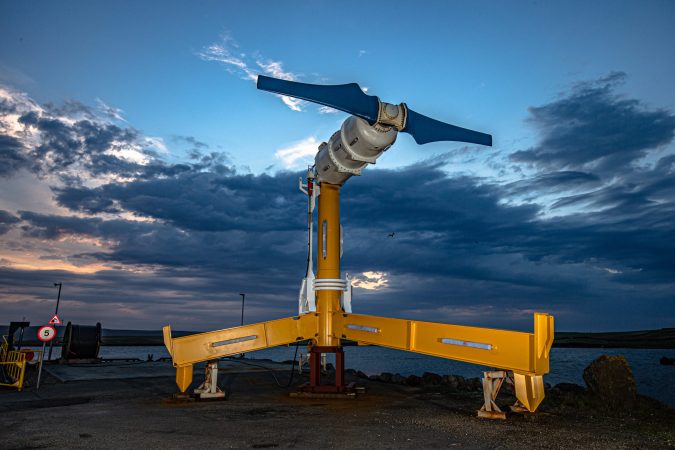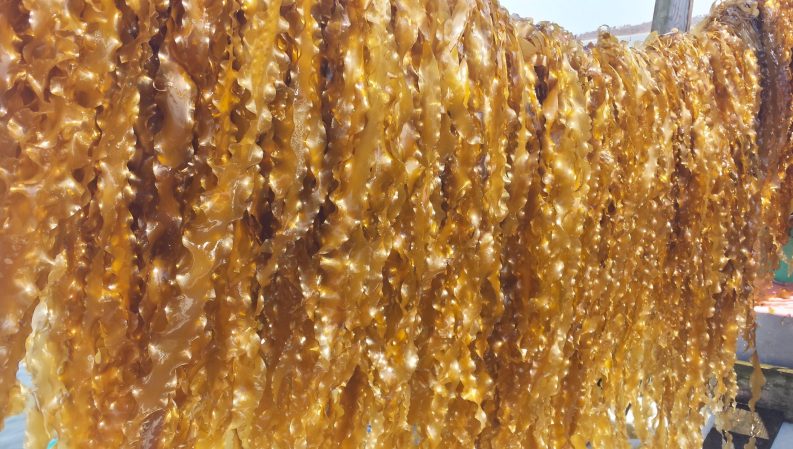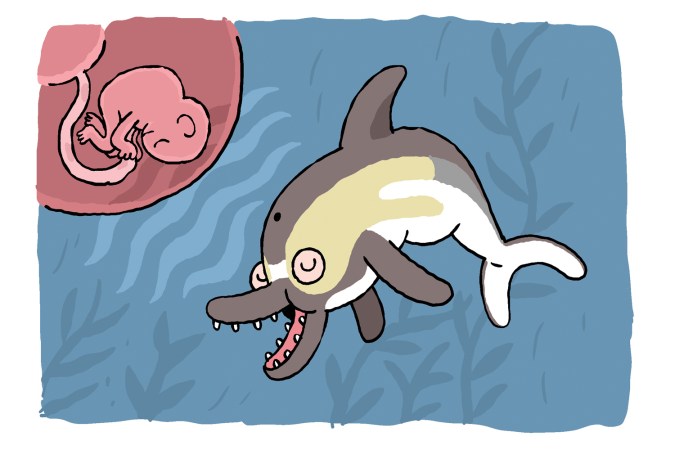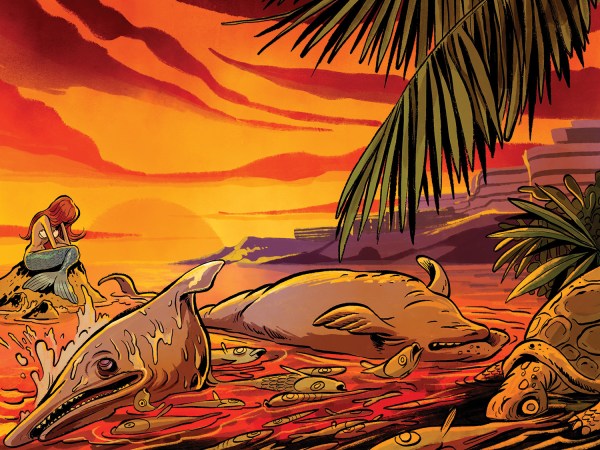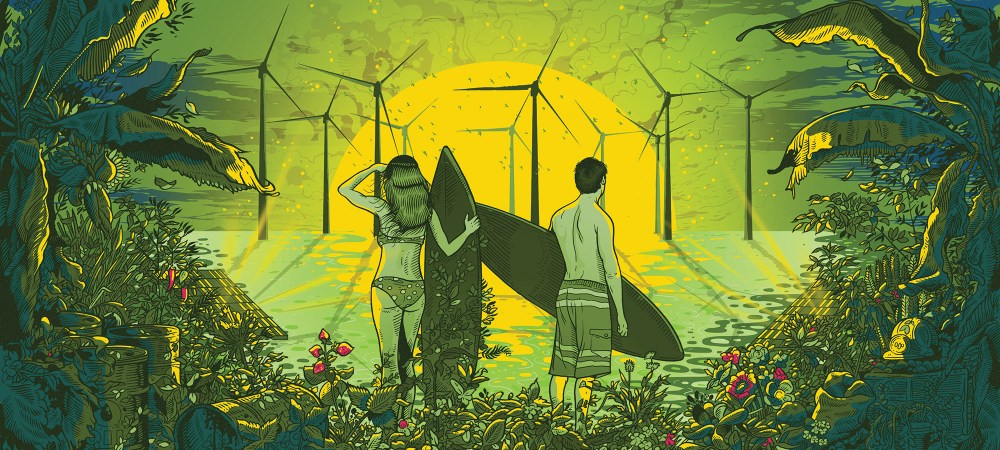

This article was originally published on Undark. Read the original article.
Last year, the Biden administration announced an ambitious goal: enough offshore wind to power 10 million homes by 2030. The move would reduce carbon emissions, create jobs, and strengthen energy security. It would also help the United States—which was responsible for just 0.1 percent of the world’s offshore wind capacity last year—catch up with renewable energy leaders like China and Europe.
The plan is already well underway: Massive turbines are rising off the coast of Massachusetts, and more projects are planned up and down the U.S. coastlines. Advocates say these turbines, and other offshore projects around the world, are a crucial tool in minimizing the effects of climate change: The technology is touted as clean, renewable, and plentiful. And, since offshore wind farms aren’t located in anyone’s backyard, they are, at least in theory, less prone to the political pushback onshore wind power has faced.
It will take a lot of turbines to meet Biden’s 2030 goal, and while wind turbines don’t use fossil fuels or generate carbon emissions, they are enormous structures, with some reaching heights of more than 850 feet above the water’s surface. (The Statue of Liberty, in comparison, stands a little over 300 feet.) As such, they will likely have some effect on the ocean environment.
Scientists already know some of the local impacts of wind farms. For example, they can, somewhat counterintuitively, reduce local wind speed. They also create their own local climates, and cause disturbances in the water in the form of a downwind wake. But what those changes might mean for marine life or for industries that depend on ocean resources is something that scientists are still trying to figure out.
Meanwhile, in the U.S., offshore wind has become the subject of bitter political disagreement and fear, fueling lobbying and lawsuits aimed at halting projects before they even begin. As researchers work to model potential outcomes, they stress that they don’t want to derail offshore wind, but rather seek to better understand it so that any negative effects can be minimized, and positive effects maximized.
Scientists have a lot more work to do before they can know the true effect of thousands of offshore wind turbines, as well as how and where they should be built. There may even be questions they haven’t thought to ask yet, said Ute Daewel, a scientist who studies marine ecosystems at The Helmholtz-Zentrum Hereon in Germany.
“It’s so complex,” she said, “that I sometimes think we probably also miss a lot of things that might happen.”
Advocates of offshore wind turbines can point to a range of benefits—starting with their proximity to the places most in need of clean energy. Around 40 percent of the world’s population lives within 60 miles of the ocean. Energy demand in densely populated coastal regions tends to be high, so offshore wind farms will be located close to where they are most needed.
Evidence suggests offshore wind power could lower energy costs, especially during extreme events like cold snaps when energy demands are high and wholesale prices peak. Meanwhile, the Department of Energy says that, in addition to reducing carbon emissions, the technology would improve human health by cutting air pollution from fossil fuels.
But wind farms have also come under intense criticism from a diverse coalition of stakeholders, including conservation nonprofits worried about the impact on marine ecosystems, fishing industry groups concerned about access to traditional fishing grounds, coastal homeowners keen to maintain their views, and groups that appear to be funded by large oil companies hoping to stifle competition.
Some of those criticisms focus on the impact on animals. Like onshore wind, the turbines can kill birds, though some researchers studying large-bodied waterbirds like sea ducks and geese have found they tend to avoid the turbines, which may mean less bird mortality offshore. Recent criticism from Republican lawmakers also suggests that the noise from offshore wind turbines might kill whales, although the National Oceanic and Atmospheric Administration says there’s no evidence to back up this concern.
Meanwhile, some research suggests wind farms might even help fish and other marine life. “A lot of people say, hey, this is going to be a habitat improvement because there’s going to be rocks on the bottom, which make artificial reefs,” said Daphne Munroe, a shellfish ecologist at Rutgers University. “And that’s absolutely true. But it’s a shift away from what was there.”
Munroe studies pressures on marine ecosystems, including the effects of climate, pollution, and resource exploitation. She’s also the lead author of a 2022 Bureau of Ocean Energy Management study on the impacts of offshore wind on surfclams—a type of clam commonly used to make chowders, soups, and stews. (The BOEM study was funded by the federal agency; Munroe has received funding from wind farm developers to conduct other projects.)
The fishing industry fears wind farms will affect their ability to yield a profitable catch — especially since the windy, shallow waters that support a rich diversity of sea life also tend to be ideal locations for turbines. Some scientists say these fears have been overblown—a 2022 study, for example, concluded that the Block Island Wind Farm located off the coast of Rhode Island does not appear to negatively impact bottom-dwelling fish. (Coastal regulators in the state of Rhode Island mandated the study be conducted and paid for by wind farm developers.) Others, like Munroe, say specific fisheries such as Atlantic surfclams will be significantly affected.
Surfclam fishing in wind farm areas, said Munroe, is logistically difficult, if not impossible, since vessels use dredges that drag though the sand to collect the clams. The presence of power cables on the ocean floor, she said, would make it too dangerous to use this kind of equipment around wind farms.
Installed boulders surrounding turbine foundations will also create obstacles, according to Munroe. “Each of the foundations is going to have what’s called scour protection,” she said. “So basically, big boulder fields that are going to be placed around the base of the turbine foundation in order to prevent the sand from scouring away.”
Currently, there are no legal restrictions on fishing in windfarm areas, Munroe said, just physical ones. “They could still get out there, but in order to fish efficiently and be able to get the catch they need and get back to the dock in a reasonable amount of time, it just wouldn’t be feasible,” she said. In her 2022 study, Munroe and her co-authors concluded that the presence of large offshore wind farms could cause fleet revenues to decline by up to 14 percent in some areas.
The industry has also been vocal about other consequences, such as habitat destruction and the possibility that the turbines’ sound might affect fish populations. In Maine, lobstermen worry that heavy mooring lines will drive their catch away. In Massachusetts, groups that represent fishing interests have filed lawsuits against the Bureau of Ocean Energy Management on the grounds that the agency failed to consider the fishing industry when it approved the 62-turbine Vineyard Wind project.
“The Bureau made limited efforts to review commercial fishing impacts,” wrote the plaintiffs in one of the Vineyard Wind lawsuits. “The limited effort that was made focused almost solely on impacts to the State of Massachusetts and on the scallop fishery, despite other fisheries being more active in the lease areas.”
Physical changes to the ecosystem, such as the placement of turbine foundations and scour protection, are some of the more obvious impacts of offshore wind turbines. But wind farms might elicit more subtle changes in local weather, affecting wind patterns and water currents, which models predict could reverberate through the food chain.
A 2023 study led by oceanographer Kaustubha Raghukumar, for example, found that turbine-driven alterations in wind speed could produce changes in ocean upwelling—a natural process where cold water from the deeper parts of the ocean rises to the surface—“outside the bounds of natural variability.” Those cold waters contain nutrients that support phytoplankton, the single-celled plants and other tiny organisms that form the basis of the oceanic food chain. Shifts in upwelling could have an impact on phytoplankton—although those impacts are still in question, particularly as climate change alters the equation.
Raghukumar and his colleagues at Integral, an environmental consulting company, based their predictions off historical data. But such an approach might not create an accurate picture of what will happen in the future as some scientists predict warmer global temperatures will produce stronger winds and increased upwelling, while others foresee localized decreases in upwelling. In their 2023 paper, which was funded by the California Energy Commission and the Ocean Protection Council, the authors noted that wind farms might reinforce—or even counteract—some of these climate change-driven changes in upwelling, but that all remains uncertain.
While Raghukumar’s study didn’t model how changes in upwelling might affect marine life, other scientists are closely studying possible changes to the ecosystem, though these are also likely to be complex and difficult to predict. A 2022 paper modeled the effect that planned wind farms might have in the North Sea, off the coasts of the U.K. and Norway, and concluded that they could influence phytoplankton, which could alter the food web.
Daewel, the study’s lead author, stopped short of drawing conclusions about what these changes might mean for the ecosystem as a whole. “We cannot say if that’s really a bad thing or a good thing because the ecosystem is very dynamic, especially in the North Sea,” she said.
Changes to ocean processes could impact fish survival, but, again, no one is really sure how. “Young fish need to be in a specific area at a specific time to find the right types of prey,” said Daewel. “So this redistribution of ecosystem parameters, that could mean that there might be a mismatch, or a better match also, for fishery life stages. But this is purely hypothetical.”
With or without wind farms, climate change is already altering the timing of critical ecosystem processes, said Robert Dorrell, lead author of a 2022 paper that investigated the effects of offshore wind on seasonally stratified shelf seas—coastal regions where water separates during the spring into different layers, with warm water at the top and colder water at the bottom. Shelf seas only represent about 8 percent of the ocean, but the phytoplankton that bloom there generate an estimated 15 to 30 percent of the organic matter that forms the basis of the food web.
In seasonally stratified shelf seas, phytoplankton grow in the upper layers, using up nutrients but also creating a food source for a myriad of marine animals. When the bloom is over, ocean mixing, a natural process driven by wind and waves, helps bring oxygen to the bottom layers and nutrients to the top, ensuring that creatures at every level can thrive. But climate change is expected to increase ocean stratification, which interferes with natural ocean mixing.
“When you have cold water underneath, which is of a higher density, that density difference makes it harder in general to mix water vertically, upwards or downwards,” said Dorrell.
Dorrell and his co-authors believe that wind farms could provide a partial solution to this problem by introducing artificial mixing of stratified shelf seas. This process, Dorrell said, is a little like stirring a cup of French coffee. “We have a nice coffee on the bottom and then you have foamy milk on the top. And if you would get a spoon and stir your French coffee you would mix the light milk up with the heavier coffee below.”
In much the same way, the downwind wake generated by an offshore turbine could help mix the warm and cold layers of water, which might help offset some of the effects of climate change.
Fortunately, scientists like Dorrell say, there is time to figure out the more subtle nuances of offshore wind and its larger effects on the marine ecosystem. “I think what we have to remember with offshore wind is that although there are plans underway at the moment, they are long-term plans,” he said. “In the U.K., for example, there are targets for 2030 certainly, but there are targets all the way through to 2050 and beyond. And there’s certainly time there for research to inform and support and maximize the best delivery of offshore wind for the benefit of everybody.”
Daewel added that papers like hers, which might suggest potential problems, aren’t an argument against wind farms. Instead, they are a call to closely monitor existing wind farms and those that will be built in the future. “I think that’s kind of the rule here, to be cautious and make sure that you understand what’s happening to your system while you’re building,” she said.
It’s possible that the way wind farms are built and where they are placed might help reduce potential negative impacts on the ocean ecosystem, though that research has yet to be done. “I think it will be a really interesting optimization kind of study, to kind of place the turbines in different locations and different densities,” said Raghukumar. The information gleaned from such a study, he said, could be used to balance the benefits of wind energy against any adverse consequences.
As research into the impacts of offshore wind energy continues, scientists say it’s important to maintain a sense of perspective, since fossil fuels also affect the ocean by driving changes to the climate.
“It’s not our intention to say this is a negative development. It’s also not our intention to say wind parks destroy the ecosystem. That’s not what our research shows,” Daewel said. “I just want to stress the research shows that we need to expect changes, and it’s better to learn that as soon as possible.”
Becki Robins is a freelance writer who lives with her family in rural Northern California. She writes about science, nature, history, and travel; her favorite stories include a little of all four. Her work has appeared in Science News, Comstock’s Magazine, Hakai Magazine, and others.
This article was originally published on Undark. Read the original article.








